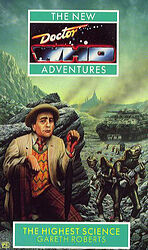
 |  |  |

 | Reviews for The Highest Science |
|
 |  |  |
There is 1 review so far. To add a review of your own for this item, visit the voting page.
| By: | David Layton, Los Angeles, United States |
|
| Date: | Tuesday 14 March 2023 |
|
| Rating: |    7 7 |
Gareth Roberts' first Doctor Who novel gives readers a good preview of his preferences for Doctor Who. He clearly prefers the intellectually lighter style of Graham Williams and Douglas Adams and so his entry here takes Doctor 7 back the 1987 version with Mel, a bit inept, with pratfalls and offbeat witticisms. As with Doctor Who of 1987 (and the 1988 story "Silver Nemesis"), The Doctor gets pitted against people with strange obsessions. It is a neat ploy that gets the writer out of having to find motivations any deeper than "I really want it." It has that Sylvester McCoy era plot of multiple entities all after the same thing, and multiple people offed one after another as collateral damage.
The plot involves The Doctor on the hunt for the source of "Fortean flickers" (named after Charles Fort, an American writer who chronicled strange and unexplained phenomena in the early 20th century). The search takes him and Bernice to the planet Sakkrat, where supposedly "The Highest Science" is kept in some ancient temple. On the planet are three groups of beings captured by the Fortean flicker. One is a trio of drug-addled misfits who were on their way to the intergalactic version of the Glastonbury Festival. Another is a group of 20th-century train passengers. The third is a force of Chelonian invaders, plucked out of time from their moment of victory. The Chelonians are bionic tortoises whose sole purpose is to wipe "mammalian parasites" off planets. Added to this is the most feared intergalactic criminal of all time - Sheldukher. He has collected a group of lesser intergalactic criminals and press-ganged them into helping him claim The Highest Science for himself.
Basically, this is a journey-to-the-center plot. It's find the lost city and claim the power, at least for some. The Chelonians have no interest in it and know nothing about it, and seem to be in the story mainly to be a major obstacle to the others. The human train travellers are there to be hapless victims needing rescue. The story has many moving parts, and Roberts seems keen to throw in as many ideas as he can come up with. Much of it is very amusing. Roberts has a very good sense of Doctor 7 from 1987. This is also the first novel in which we really see what Benny is like as a companion. For the most part, I could see this story fitting very comfortably within the first season of Sylvester McCoy's run.
I find that the casualness of tone in these kinds of stories leads to a disturbing casualness of ethics. It comes across early in this novel when the people of Vaagon are saved from destruction at the hands of the Chelonians, only to be wiped out in about three casually tossed in sentences 300 years later by another group of Chelonians, with the writer taking a "hey-ho, that's life, what can you do?" attitude toward the whole thing. This casualness about genocide, because hey it is funny that the genocidal maniacs are munching leaves while doing it, is the writer's choice. He did not have to put in this detail. He had already established how homicidal the Chelonians are. The detail adds nothing to the plot, yet there it is. This casualness becomes extremely disturbing to me by the novel's end. Here, having gotten to a point where a group of English commuters, plucked out of their own time and plopped onto a future alien world, are about to be wiped out, and The Doctor's only solution is to freeze them in "slow time." That would be fine, except he simply abandons them all at this point, his only comment being that he will at some point probably, perhaps, maybe, come back and rescue them. And then he and Benny move on happy to have survived the whole catastrophe, with no mention of it again. There they are, all these people, stuck at the point of destruction, and The Doctor and Benny simply forget about them after about half an hour. The reader should keep in mind that one of these forgotten humans is a baby that Roberts went out of his way earlier in the novel to put into danger for the sole purpose of showing how nasty the villain Sheldukher is. For what purpose has Roberts written this ending? If it is to demythologize The Doctor, he had already done that in dozens of ways in this novel, so there is no need to do it yet again. It appears more likely that Roberts had not really thought about it that much. He wanted some kind of nifty idea for an ending and never bothered to consider the ethical implications of his idea. [On a side note, the situation is finally rectified in Paul Cornell's Happy Endings, written years later. Even there, Romana is the one to fix the problem, not The Doctor, who, as far as we know, never went back. This was part of the purpose of Happy Endings, tie up all the loose ends of previous New Adventures novels. So, Roberts had no intention, as far as the evidence goes, of straightening this out and restoring The Doctor's status as a moral hero, and neither did Cornell.] So, what I see is that Roberts created a tangled mess of an ending, and could not see a way out of it, even though the way was obviously staring him in the face. It strikes me as Roberts' casual disregard for the intelligence and sensibilities of the reader.


